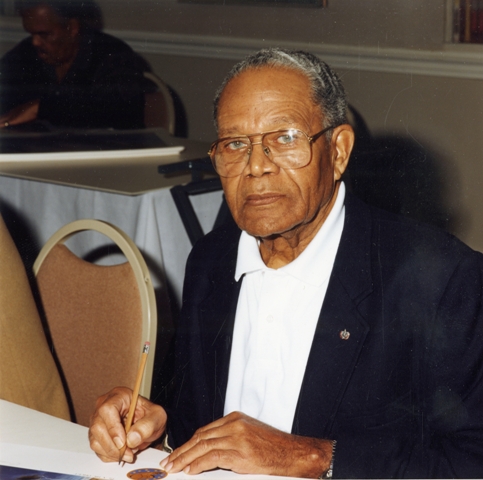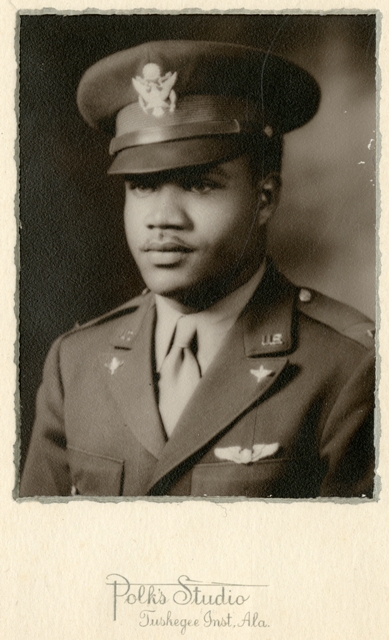 The Smithsonian Institution Archives will be celebrating African American History Month throughout February with a series of related posts on THE BIGGER PICTURE. The Smithsonian Institution Archives (SIA) houses a unique collection of Oral and Video Histories that I have the privilege of working with everyday. These histories capture the stories of the people who helped shape the Smithsonian, and so it is always a thrill for me when we can make one of these valuable recordings available.
The Smithsonian Institution Archives will be celebrating African American History Month throughout February with a series of related posts on THE BIGGER PICTURE. The Smithsonian Institution Archives (SIA) houses a unique collection of Oral and Video Histories that I have the privilege of working with everyday. These histories capture the stories of the people who helped shape the Smithsonian, and so it is always a thrill for me when we can make one of these valuable recordings available.  I recently had the luck of talking to an interviewee’s daughter who contacted us because she was interested in hearing her father’s recorded stories. Her father, Louis R. Purnell, was an influential curator at the National Air and Space Museum from 1968 to 1985, and a Tuskegee Airman, as well. Once I explained to her that the collection deed, paperwork opening the collections for the public, was never finalized before her father passed away in 2001, she quickly sent me the signed paperwork, recognizing the importance in sharing her father’s story. Born in 1920 in Snow Hill, Maryland into a family of teachers, Purnell understood the importance of education, especially self-education. He became a keen observer to learn about the world around him and recalls, in the recording, “I just liked people, and I'd stand back and watch them and marvel at how many different types of people there were in the world and how different they were from each other.” When his family moved to a mostly white neighborhood in New Jersey, Purnell’s father warned him, "In order to appear equal to, you have to be twice as good." Purnell met the challenge. From a very early age he loved flight and spent hours watching planes land, wondering how one man controlled such a powerful machine. While attending Lincoln University, Purnell earned a private pilot license, rare for a black man in that era. With World War II looming, Purnell went to the Tuskegee Institute, the only school in the nation that provided advanced pilot classes for blacks, and was accepted into the seventh class of African American Army Air Force cadets in 1942. According to Purnell, “The wash-out rate was exceptionally high. Thirty cadets would go in, maybe ten of them would graduate…So those that came through, you knew that they had it. It was a struggle.” Purnell served in the all-Black 99th Fighter squadron and later the 332nd Fighter group, known as the Tuskegee Airmen, completing two tours of combat duty in Africa and Italy.
I recently had the luck of talking to an interviewee’s daughter who contacted us because she was interested in hearing her father’s recorded stories. Her father, Louis R. Purnell, was an influential curator at the National Air and Space Museum from 1968 to 1985, and a Tuskegee Airman, as well. Once I explained to her that the collection deed, paperwork opening the collections for the public, was never finalized before her father passed away in 2001, she quickly sent me the signed paperwork, recognizing the importance in sharing her father’s story. Born in 1920 in Snow Hill, Maryland into a family of teachers, Purnell understood the importance of education, especially self-education. He became a keen observer to learn about the world around him and recalls, in the recording, “I just liked people, and I'd stand back and watch them and marvel at how many different types of people there were in the world and how different they were from each other.” When his family moved to a mostly white neighborhood in New Jersey, Purnell’s father warned him, "In order to appear equal to, you have to be twice as good." Purnell met the challenge. From a very early age he loved flight and spent hours watching planes land, wondering how one man controlled such a powerful machine. While attending Lincoln University, Purnell earned a private pilot license, rare for a black man in that era. With World War II looming, Purnell went to the Tuskegee Institute, the only school in the nation that provided advanced pilot classes for blacks, and was accepted into the seventh class of African American Army Air Force cadets in 1942. According to Purnell, “The wash-out rate was exceptionally high. Thirty cadets would go in, maybe ten of them would graduate…So those that came through, you knew that they had it. It was a struggle.” Purnell served in the all-Black 99th Fighter squadron and later the 332nd Fighter group, known as the Tuskegee Airmen, completing two tours of combat duty in Africa and Italy.  In 1961, Purnell joined the Division of Invertebrate Zoology at the National Museum of Natural History (NMNH) as a museum specialist, he worked with specimens and participated in collecting trips. Despite a lack of formal biology education, Purnell published a type specimens catalogue of invertebrate fossils. He studied geology at The George Washington University and became particularly skilled at the identification of nautiloids or the cephalopods, because he thought “they were beautiful things and just to look at them and see how they were formed” became a challenging mystery. At times, Purnell’s successes were viewed as threats, both academically and racially. After being overlooked for promotions, Purnell transferred to the National Air and Space Museum (NASM). His NMNH supervisor, urged Purnell to stay, saying "I'll never forgive you for leaving our section." Purnell first applied to NASM’s Aeronautics Department, but was rebuffed by racial prejudices. Instead he was offered a position in the Astronautics Department. Purnell began work there as a Museum Specialist in 1968, an exciting time in the history of space. The 1969 landing on the moon propelled public interest in space and the Museum’s new home on the National Mall was being completed. With collections being enhanced and exhibits remodeled, Purnell hit the ground running. He quickly gained the respect of the Astronautics Chair, Frederick C. Durant, who called Purnell his “right-hand man.” By 1971, Durant placed Purnell in charge of the removal of the Apollo 4 and placement of the Apollo 11 Command Module as well as organizing the new Spacecraft Exhibit. By 1972, Purnell became Assistant Curator and an expert of spacesuits, and completed the exhibit Spacecraft and Spacesuits, involving collections from Mercury, Gemini, and Apollo. For almost twenty years, Purnell cared for and exhibited the space collections at the Museum—you can hear Purnell talk about his work at NASM in his own words below:
In 1961, Purnell joined the Division of Invertebrate Zoology at the National Museum of Natural History (NMNH) as a museum specialist, he worked with specimens and participated in collecting trips. Despite a lack of formal biology education, Purnell published a type specimens catalogue of invertebrate fossils. He studied geology at The George Washington University and became particularly skilled at the identification of nautiloids or the cephalopods, because he thought “they were beautiful things and just to look at them and see how they were formed” became a challenging mystery. At times, Purnell’s successes were viewed as threats, both academically and racially. After being overlooked for promotions, Purnell transferred to the National Air and Space Museum (NASM). His NMNH supervisor, urged Purnell to stay, saying "I'll never forgive you for leaving our section." Purnell first applied to NASM’s Aeronautics Department, but was rebuffed by racial prejudices. Instead he was offered a position in the Astronautics Department. Purnell began work there as a Museum Specialist in 1968, an exciting time in the history of space. The 1969 landing on the moon propelled public interest in space and the Museum’s new home on the National Mall was being completed. With collections being enhanced and exhibits remodeled, Purnell hit the ground running. He quickly gained the respect of the Astronautics Chair, Frederick C. Durant, who called Purnell his “right-hand man.” By 1971, Durant placed Purnell in charge of the removal of the Apollo 4 and placement of the Apollo 11 Command Module as well as organizing the new Spacecraft Exhibit. By 1972, Purnell became Assistant Curator and an expert of spacesuits, and completed the exhibit Spacecraft and Spacesuits, involving collections from Mercury, Gemini, and Apollo. For almost twenty years, Purnell cared for and exhibited the space collections at the Museum—you can hear Purnell talk about his work at NASM in his own words below:
Purnell’s inquisitive nature drove him to learn about and become an expert in the topics that piqued his interest. His service to both this Institution and the United States has fortunately been preserved in his own words, as he lived it.
Produced by the Smithsonian Institution Archives. For copyright questions, please see the Terms of Use.

Leave a Comment